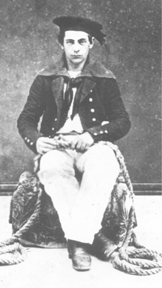Monkey jacket
Monkey jacket is a type of short, close-fitting jacket, often made of wool or a wool blend, historically worn by sailors in the Royal Navy. The term "monkey jacket" is believed to have originated in the early 19th century, though the exact origins of the name are unclear. Some theories suggest it was named for its compact size and streamlined fit, making it suitable for the agile movements required on a ship, similar to a monkey's agility. Others propose it was derived from the jackets worn by monkey mascots and pets aboard ships. Regardless of its etymology, the monkey jacket has become a notable piece of naval attire, recognized for its practicality and historical significance.
Design and Features[edit | edit source]
The traditional monkey jacket is characterized by its short length, typically ending at the waist, and a close fit to the body. It usually features a high collar, long sleeves, and is fastened with buttons at the front. The cuffs and the bottom of the jacket are often finished with ribbed knitting to ensure a snug fit that prevents the jacket from catching wind or interfering with the sailor's duties. While originally made from wool to provide warmth and resist water, modern variations of the monkey jacket can be found in a variety of materials, including synthetic blends.
Historical Significance[edit | edit source]
The monkey jacket was an integral part of the sailor's uniform in the 19th and early 20th centuries, serving both functional and ceremonial purposes. Its design allowed for ease of movement while protecting the wearer from the harsh marine environment. Over time, the jacket transcended its naval origins, influencing civilian fashion. It became popular among various subcultures in the 20th century, particularly in the mod scene of the 1960s in the United Kingdom, where it was prized for its sleek, stylish appearance.
Modern Usage[edit | edit source]
Today, the monkey jacket maintains a presence both in military ceremonial uniforms and in civilian fashion. In the military context, it is often adorned with badges and insignia that denote rank and affiliation. In civilian attire, it has been adopted and adapted by various fashion movements, appreciated for its blend of functionality and style. Designers have reinterpreted the monkey jacket in numerous ways, experimenting with colors, patterns, and materials, while still retaining the essence of its original design.
Cultural Impact[edit | edit source]
The monkey jacket's transition from a strictly utilitarian garment to a fashion statement reflects broader trends in the adaptation of military wear by civilian populations. Its enduring appeal lies in its simplicity, versatility, and the sense of heritage it conveys. As a piece of clothing that has navigated the passage of time, the monkey jacket stands as a testament to the influence of military attire on fashion and culture at large.
Search WikiMD
Ad.Tired of being Overweight? Try W8MD's physician weight loss program.
Semaglutide (Ozempic / Wegovy and Tirzepatide (Mounjaro / Zepbound) available.
Advertise on WikiMD
|
WikiMD's Wellness Encyclopedia |
| Let Food Be Thy Medicine Medicine Thy Food - Hippocrates |
Translate this page: - East Asian
中文,
日本,
한국어,
South Asian
हिन्दी,
தமிழ்,
తెలుగు,
Urdu,
ಕನ್ನಡ,
Southeast Asian
Indonesian,
Vietnamese,
Thai,
မြန်မာဘာသာ,
বাংলা
European
español,
Deutsch,
français,
Greek,
português do Brasil,
polski,
română,
русский,
Nederlands,
norsk,
svenska,
suomi,
Italian
Middle Eastern & African
عربى,
Turkish,
Persian,
Hebrew,
Afrikaans,
isiZulu,
Kiswahili,
Other
Bulgarian,
Hungarian,
Czech,
Swedish,
മലയാളം,
मराठी,
ਪੰਜਾਬੀ,
ગુજરાતી,
Portuguese,
Ukrainian
Medical Disclaimer: WikiMD is not a substitute for professional medical advice. The information on WikiMD is provided as an information resource only, may be incorrect, outdated or misleading, and is not to be used or relied on for any diagnostic or treatment purposes. Please consult your health care provider before making any healthcare decisions or for guidance about a specific medical condition. WikiMD expressly disclaims responsibility, and shall have no liability, for any damages, loss, injury, or liability whatsoever suffered as a result of your reliance on the information contained in this site. By visiting this site you agree to the foregoing terms and conditions, which may from time to time be changed or supplemented by WikiMD. If you do not agree to the foregoing terms and conditions, you should not enter or use this site. See full disclaimer.
Credits:Most images are courtesy of Wikimedia commons, and templates, categories Wikipedia, licensed under CC BY SA or similar.
Contributors: Prab R. Tumpati, MD

